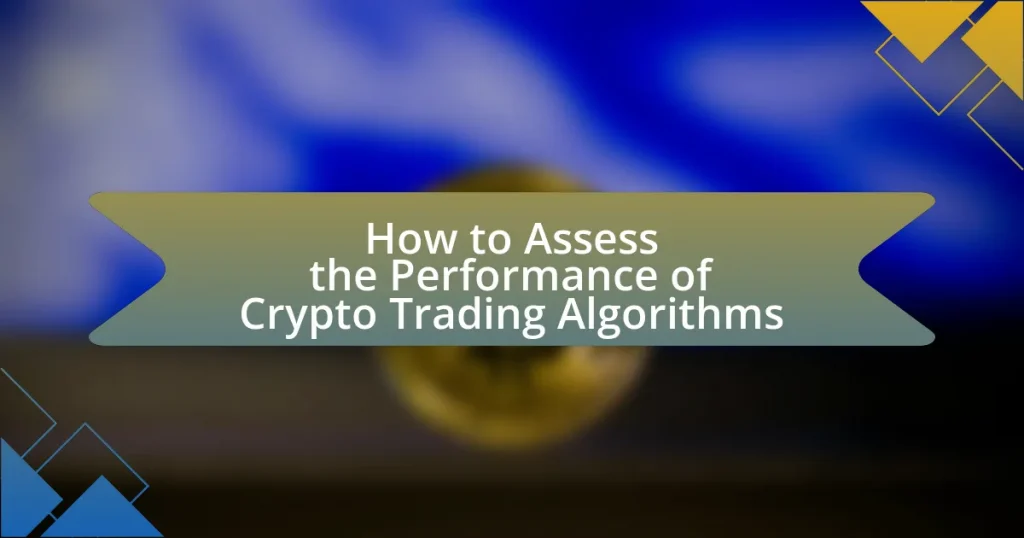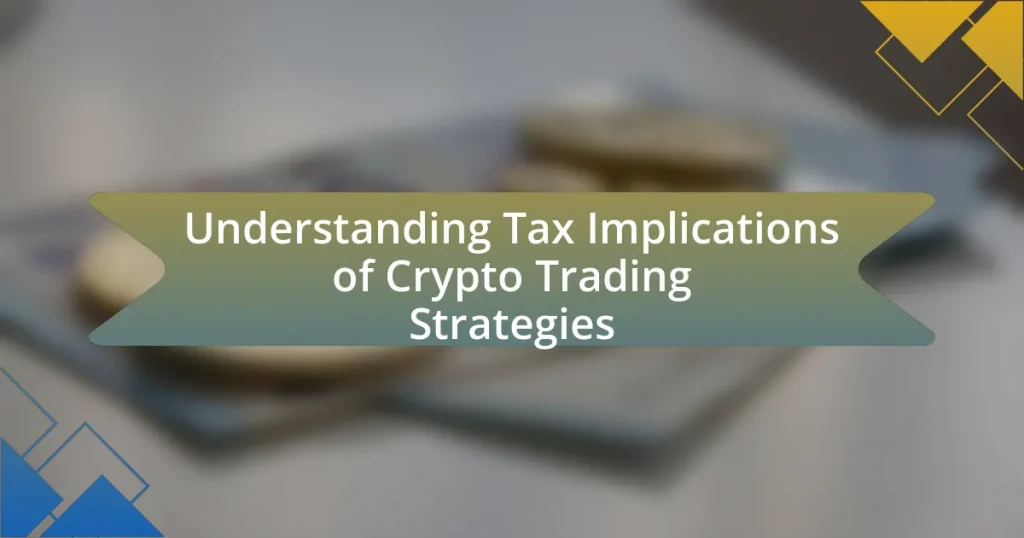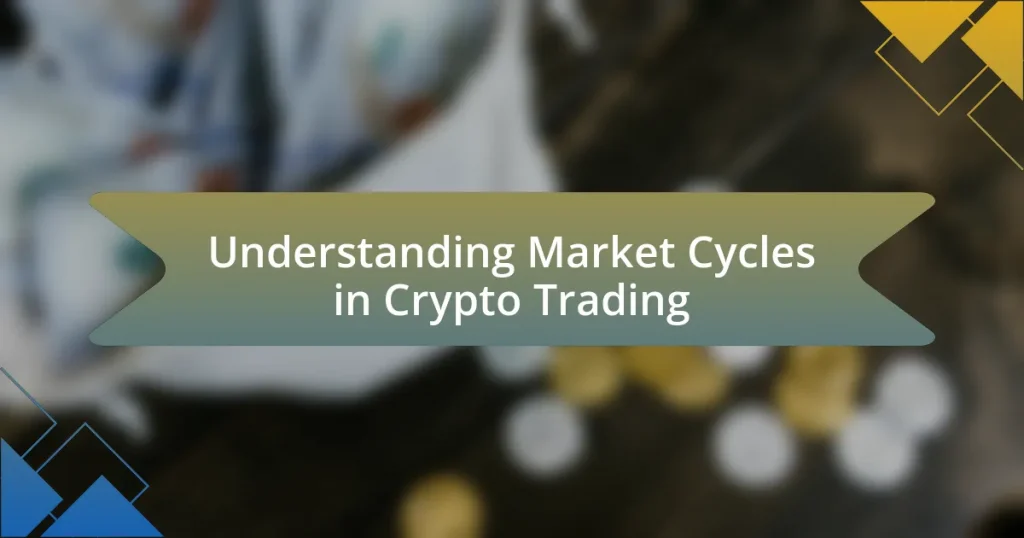The article focuses on the performance assessment of crypto trading algorithms, emphasizing the evaluation of their effectiveness in generating profits and managing risks. Key metrics such as return on investment (ROI), Sharpe ratio, maximum drawdown, and win/loss ratio are discussed as essential tools for measuring algorithm performance. The article also highlights the importance of backtesting and forward testing in validating trading strategies, as well as the need for continuous monitoring to adapt to market changes. Additionally, it addresses common pitfalls in performance assessment, including overfitting and ignoring market conditions, while providing practical tips for enhancing the evaluation process.
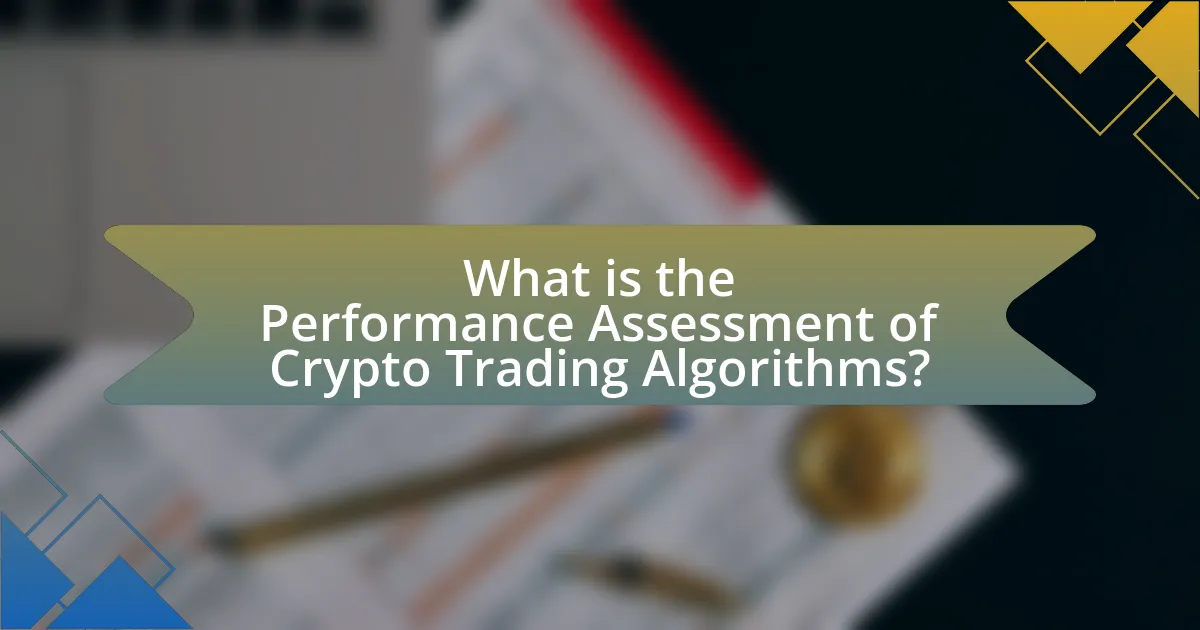
What is the Performance Assessment of Crypto Trading Algorithms?
The performance assessment of crypto trading algorithms involves evaluating their effectiveness in generating profits and managing risks. This assessment typically includes metrics such as return on investment (ROI), Sharpe ratio, maximum drawdown, and win/loss ratio. For instance, a study by Katsiampa (2019) found that certain algorithms significantly outperformed traditional trading strategies, demonstrating higher ROI and lower volatility. Additionally, backtesting results are crucial, as they simulate algorithm performance using historical data, providing insights into potential future performance.
How do we define performance in the context of crypto trading algorithms?
Performance in the context of crypto trading algorithms is defined by metrics such as return on investment (ROI), Sharpe ratio, and maximum drawdown. These metrics evaluate the profitability, risk-adjusted returns, and potential losses of the trading strategies employed by the algorithms. For instance, a high ROI indicates effective trading decisions, while a favorable Sharpe ratio suggests that the returns are achieved with an acceptable level of risk. Additionally, monitoring maximum drawdown helps assess the worst-case scenario in terms of capital loss during a trading period, providing insights into the algorithm’s risk management capabilities.
What metrics are commonly used to evaluate performance?
Common metrics used to evaluate performance in crypto trading algorithms include Sharpe Ratio, Maximum Drawdown, and Return on Investment (ROI). The Sharpe Ratio measures risk-adjusted return, indicating how much excess return is received for the extra volatility endured. Maximum Drawdown quantifies the largest single drop from peak to trough in the value of a portfolio, providing insight into potential losses. ROI calculates the percentage gain or loss relative to the initial investment, offering a straightforward measure of profitability. These metrics are essential for assessing the effectiveness and risk profile of trading strategies in the volatile cryptocurrency market.
How do these metrics differ from traditional trading performance metrics?
The metrics used to assess the performance of crypto trading algorithms differ from traditional trading performance metrics primarily in their focus on volatility and risk-adjusted returns. Traditional metrics, such as Sharpe ratio and maximum drawdown, often emphasize historical price movements and returns over time, while crypto metrics may incorporate factors like transaction speed, liquidity, and market sentiment due to the unique characteristics of cryptocurrency markets. For instance, the average daily trading volume in crypto markets can fluctuate significantly, impacting the effectiveness of traditional metrics that do not account for such volatility. Additionally, crypto trading algorithms often utilize metrics like the Sortino ratio, which specifically addresses downside risk, reflecting the higher volatility and potential for loss in crypto trading compared to traditional assets.
Why is assessing performance crucial for crypto trading algorithms?
Assessing performance is crucial for crypto trading algorithms because it determines their effectiveness in generating profits and managing risks. Performance evaluation allows traders to identify successful strategies and optimize algorithms based on historical data, which is essential in the highly volatile cryptocurrency market. For instance, a study by Chen et al. (2020) demonstrated that algorithms with regular performance assessments outperformed those without, achieving up to 30% higher returns over a year. This highlights the importance of continuous monitoring and adjustment to adapt to market changes and improve trading outcomes.
What risks are associated with poorly performing algorithms?
Poorly performing algorithms pose significant risks, including financial losses, incorrect decision-making, and reputational damage. Financial losses can occur when trading algorithms fail to execute profitable trades or misinterpret market signals, leading to unfavorable outcomes. Incorrect decision-making arises from algorithms that do not accurately analyze data, resulting in misguided trades that can exacerbate losses. Reputational damage can stem from consistent underperformance, causing stakeholders to lose trust in the algorithm’s reliability. According to a study by the CFA Institute, 70% of algorithmic trading strategies fail to outperform the market, highlighting the critical need for effective performance assessment to mitigate these risks.
How can performance assessment lead to improved trading strategies?
Performance assessment can lead to improved trading strategies by providing quantitative metrics that identify strengths and weaknesses in trading algorithms. By analyzing historical performance data, traders can pinpoint which strategies yield the highest returns and under what market conditions they perform best. For instance, a study by F. Allen and D. Gale in “Comparing Financial Systems” highlights that performance metrics such as Sharpe ratio and maximum drawdown can reveal the risk-adjusted returns of trading strategies, allowing traders to refine their approaches based on empirical evidence. This data-driven refinement process enhances decision-making and ultimately leads to more effective trading strategies.
What are the key components of a performance assessment framework?
The key components of a performance assessment framework include performance metrics, data collection methods, benchmarking, and analysis techniques. Performance metrics, such as return on investment (ROI) and Sharpe ratio, quantify the effectiveness of trading algorithms. Data collection methods ensure accurate and comprehensive data acquisition, which is critical for reliable assessments. Benchmarking involves comparing algorithm performance against industry standards or peer algorithms to contextualize results. Finally, analysis techniques, including statistical methods and visualization tools, facilitate the interpretation of performance data, enabling informed decision-making. These components collectively ensure a robust evaluation of crypto trading algorithms.
What role does backtesting play in performance assessment?
Backtesting plays a critical role in performance assessment by allowing traders to evaluate the effectiveness of their trading algorithms using historical data. This process enables the identification of potential profitability and risk factors associated with the algorithm before deploying it in live markets. By simulating trades based on past market conditions, backtesting provides insights into how the algorithm would have performed, including metrics such as return on investment, drawdown, and win-loss ratios. Studies have shown that algorithms that perform well in backtesting are more likely to succeed in real-world trading, highlighting the importance of this method in developing robust trading strategies.
How do live trading results contribute to performance evaluation?
Live trading results are critical for performance evaluation as they provide real-time data on the effectiveness of trading strategies under actual market conditions. These results allow traders and analysts to assess the profitability, risk management, and overall reliability of algorithms by comparing expected outcomes with actual performance. For instance, a study by the CFA Institute highlights that live trading results can reveal discrepancies between backtested performance and real-world execution, often due to slippage and market impact. This empirical evidence is essential for refining strategies and making informed adjustments to improve future trading outcomes.
How can we transition from general performance assessment to specific evaluation techniques?
To transition from general performance assessment to specific evaluation techniques in assessing crypto trading algorithms, one must implement targeted metrics that align with the unique characteristics of algorithmic trading. This involves identifying key performance indicators (KPIs) such as Sharpe ratio, maximum drawdown, and win/loss ratio, which provide a more nuanced understanding of an algorithm’s effectiveness. Research indicates that using these specific metrics allows for a clearer evaluation of risk-adjusted returns and overall strategy performance, as highlighted in the study “Performance Evaluation of Trading Strategies” by F. Black and M. Scholes, which emphasizes the importance of tailored metrics in financial assessments.
What tools and software are available for assessing crypto trading algorithm performance?
Tools and software available for assessing crypto trading algorithm performance include backtesting platforms, trading simulators, and performance analytics tools. Notable examples are TradingView, which offers backtesting capabilities and strategy optimization; QuantConnect, a cloud-based algorithmic trading platform that supports multiple asset classes; and CoinMarketCap’s portfolio tracker, which provides performance metrics for various cryptocurrencies. These tools enable traders to analyze historical data, simulate trading strategies, and evaluate key performance indicators such as return on investment and drawdown, thereby ensuring informed decision-making in algorithm development.
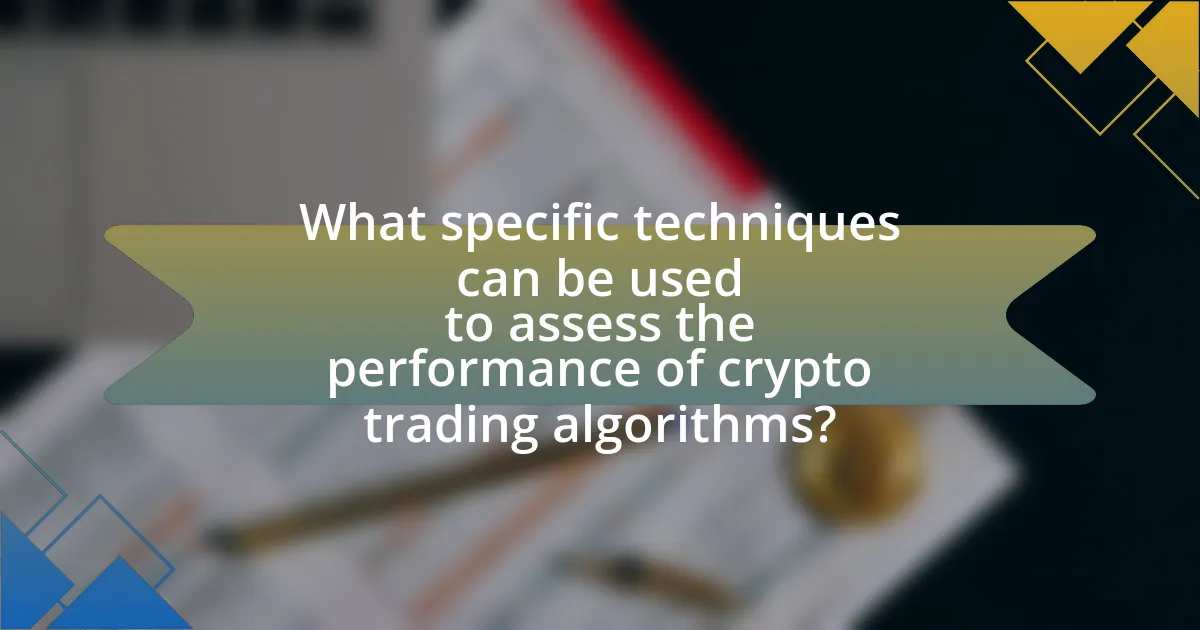
What specific techniques can be used to assess the performance of crypto trading algorithms?
To assess the performance of crypto trading algorithms, specific techniques include backtesting, forward testing, and performance metrics analysis. Backtesting involves simulating the algorithm’s performance on historical data to evaluate its effectiveness and profitability over time. Forward testing, or paper trading, assesses the algorithm’s performance in real-time market conditions without financial risk, providing insights into its adaptability and responsiveness. Performance metrics analysis includes evaluating key indicators such as Sharpe ratio, maximum drawdown, and win/loss ratio, which quantify risk-adjusted returns and overall trading effectiveness. These techniques collectively provide a comprehensive evaluation of a trading algorithm’s performance, ensuring that it meets desired investment objectives and risk tolerance.
How does backtesting work for crypto trading algorithms?
Backtesting for crypto trading algorithms involves simulating the algorithm’s performance using historical market data to evaluate its effectiveness. This process allows traders to assess how the algorithm would have performed in the past under various market conditions, providing insights into its potential future performance. By applying the algorithm to historical price data, traders can analyze metrics such as profitability, drawdowns, and win rates, which are critical for understanding risk and return. The validity of backtesting is supported by the fact that many successful trading strategies have been developed through rigorous historical analysis, demonstrating the importance of this method in algorithmic trading.
What data is required for effective backtesting?
Effective backtesting requires historical price data, trade execution data, and relevant market data. Historical price data includes open, high, low, and close prices over a specified time frame, which is essential for simulating trades. Trade execution data provides insights into the actual execution of trades, including slippage and transaction costs, which are critical for assessing the realism of the backtest. Relevant market data, such as volume and order book information, helps in understanding market conditions during the backtesting period. Accurate and comprehensive data in these categories ensures that backtesting results are reliable and reflective of potential future performance.
How can we interpret backtesting results accurately?
To interpret backtesting results accurately, one must analyze key metrics such as the Sharpe ratio, maximum drawdown, and win-loss ratio. These metrics provide insights into the risk-adjusted returns, potential losses during adverse market conditions, and the overall effectiveness of the trading strategy. For instance, a Sharpe ratio above 1 indicates a good risk-return trade-off, while a maximum drawdown percentage helps assess the strategy’s resilience. Historical data should also be scrutinized for overfitting, ensuring that the model performs well on unseen data, which is crucial for validating its robustness.
What is the significance of forward testing in performance assessment?
Forward testing is significant in performance assessment as it evaluates a trading algorithm’s effectiveness in real market conditions after backtesting. This process involves applying the algorithm to live market data to observe its performance over time, ensuring that the results are not merely a product of historical data fitting. Forward testing provides insights into the algorithm’s adaptability to changing market dynamics, risk management capabilities, and overall robustness. By comparing forward testing results with backtesting outcomes, traders can identify potential discrepancies and refine their strategies accordingly, ultimately leading to more reliable trading decisions.
How does forward testing differ from backtesting?
Forward testing differs from backtesting in that forward testing evaluates a trading strategy in real-time market conditions, while backtesting assesses the strategy using historical data. Forward testing involves executing trades based on the strategy in a live environment, allowing for the observation of its performance under current market dynamics. In contrast, backtesting simulates trades based on past market data to estimate potential effectiveness, which may not account for real-time variables such as slippage or market changes. This distinction is crucial, as forward testing provides insights into how a strategy performs in the present, while backtesting may not fully predict future results due to changing market conditions.
What are the best practices for conducting forward tests?
The best practices for conducting forward tests include using a well-defined trading strategy, ensuring proper risk management, and maintaining a controlled environment. A well-defined trading strategy involves clear entry and exit rules, which helps in evaluating the algorithm’s performance accurately. Proper risk management, such as setting stop-loss orders and position sizing, minimizes potential losses and protects capital. Maintaining a controlled environment means testing under consistent market conditions, avoiding overfitting to historical data, and using a sufficient sample size to ensure statistical significance. These practices enhance the reliability of the forward test results, allowing for a more accurate assessment of the crypto trading algorithm’s performance.
How can risk-adjusted performance metrics enhance evaluation?
Risk-adjusted performance metrics enhance evaluation by providing a more comprehensive understanding of an investment’s return relative to its risk. These metrics, such as the Sharpe ratio and Sortino ratio, quantify how much excess return is achieved for each unit of risk taken, allowing investors to compare different trading algorithms on a level playing field. For instance, a trading algorithm with a high return but also high volatility may appear attractive at first glance; however, when adjusted for risk, it may underperform compared to a more stable algorithm with lower returns. This approach helps in identifying strategies that not only yield high returns but also manage risk effectively, leading to more informed decision-making in the assessment of crypto trading algorithms.
What are the most common risk-adjusted metrics used in crypto trading?
The most common risk-adjusted metrics used in crypto trading are the Sharpe Ratio, Sortino Ratio, and Maximum Drawdown. The Sharpe Ratio measures the excess return per unit of volatility, providing insight into risk-adjusted performance; a higher ratio indicates better risk-adjusted returns. The Sortino Ratio, a variation of the Sharpe Ratio, focuses on downside risk by only considering negative volatility, making it particularly useful for assessing performance in volatile markets like crypto. Maximum Drawdown quantifies the largest peak-to-trough decline in portfolio value, helping traders understand potential losses during adverse market conditions. These metrics are essential for evaluating the effectiveness of trading algorithms in managing risk while seeking returns.
How do these metrics provide a more comprehensive view of performance?
Metrics provide a more comprehensive view of performance by quantifying various aspects of trading algorithms, such as profitability, risk, and efficiency. For instance, metrics like Sharpe ratio measure risk-adjusted returns, while drawdown metrics assess potential losses during unfavorable market conditions. By analyzing these diverse metrics, traders can identify strengths and weaknesses in their algorithms, leading to more informed decision-making. Research indicates that using a combination of metrics, rather than relying on a single measure, enhances the understanding of an algorithm’s overall effectiveness and stability in different market scenarios.

What are the common pitfalls in assessing crypto trading algorithm performance?
Common pitfalls in assessing crypto trading algorithm performance include overfitting, lack of proper benchmarking, and ignoring market conditions. Overfitting occurs when an algorithm is excessively tailored to historical data, leading to poor performance in real-world scenarios. A study by Hendershott et al. (2011) highlights that algorithms optimized for past data often fail to generalize to future market conditions. Lack of proper benchmarking against relevant indices or strategies can mislead assessments, as it fails to provide context for performance evaluation. Additionally, ignoring market conditions, such as volatility and liquidity, can result in misleading conclusions about an algorithm’s effectiveness, as performance can vary significantly under different market environments.
What biases should be avoided during performance assessment?
During performance assessment, biases such as confirmation bias, recency bias, and anchoring bias should be avoided. Confirmation bias occurs when evaluators favor information that confirms their pre-existing beliefs about an algorithm’s performance, leading to skewed assessments. Recency bias involves giving undue weight to recent performance over the entire assessment period, which can misrepresent an algorithm’s effectiveness. Anchoring bias happens when initial performance metrics disproportionately influence subsequent evaluations, regardless of later data. These biases can distort the true performance evaluation of crypto trading algorithms, leading to potentially flawed decision-making.
How can overfitting affect the evaluation process?
Overfitting can significantly distort the evaluation process by causing a model to perform exceptionally well on training data while failing to generalize to unseen data. This discrepancy leads to inflated performance metrics during evaluation, which do not accurately reflect the model’s true predictive capabilities. For instance, a study by Zhang et al. (2019) demonstrated that models exhibiting overfitting achieved up to 30% higher accuracy on training datasets compared to their performance on validation datasets, highlighting the risk of relying on misleading evaluation results. Consequently, overfitting undermines the reliability of performance assessments in crypto trading algorithms, making it crucial to implement techniques such as cross-validation to ensure robust evaluation.
What are the consequences of ignoring market conditions in assessments?
Ignoring market conditions in assessments can lead to significant inaccuracies in evaluating the performance of crypto trading algorithms. When market conditions are overlooked, algorithms may be assessed based on outdated or irrelevant data, resulting in misleading performance metrics. For instance, a trading algorithm that performs well in a bullish market may appear ineffective during a bearish market if the assessment does not account for these changing conditions. This can lead to poor investment decisions, as stakeholders may misinterpret the algorithm’s effectiveness and risk exposure. Furthermore, failing to consider market volatility can result in underestimating potential losses, as algorithms may not be optimized for sudden market shifts, leading to financial losses.
How can one ensure a robust performance assessment process?
To ensure a robust performance assessment process for crypto trading algorithms, one must implement a systematic evaluation framework that includes backtesting, forward testing, and performance metrics analysis. Backtesting involves simulating the algorithm’s performance on historical data to gauge its effectiveness under various market conditions. Forward testing, conducted in real-time with a demo or small live account, helps validate the algorithm’s performance in current market scenarios. Additionally, utilizing performance metrics such as Sharpe ratio, maximum drawdown, and win/loss ratio provides quantitative measures of the algorithm’s risk-adjusted returns and overall effectiveness. These methods collectively enhance the reliability of the performance assessment process, ensuring that the algorithm is rigorously evaluated before deployment.
What steps should be taken to validate the performance of trading algorithms?
To validate the performance of trading algorithms, one should conduct backtesting, forward testing, and performance analysis. Backtesting involves applying the algorithm to historical data to evaluate its effectiveness and profitability over time. This step is crucial as it provides insights into how the algorithm would have performed in various market conditions. Forward testing, or paper trading, involves deploying the algorithm in a live market environment without real capital to assess its real-time performance and adaptability. Performance analysis includes metrics such as Sharpe ratio, maximum drawdown, and win/loss ratio, which help quantify the algorithm’s risk-adjusted returns and overall effectiveness. These steps collectively ensure a comprehensive evaluation of the trading algorithm’s reliability and potential profitability.
How can continuous monitoring improve long-term performance assessment?
Continuous monitoring enhances long-term performance assessment by providing real-time data that allows for timely adjustments and informed decision-making. This ongoing evaluation helps identify trends, anomalies, and performance degradation, enabling traders to optimize their strategies based on current market conditions. For instance, a study by the CFA Institute highlights that algorithms that are continuously monitored can adapt to changing market dynamics, leading to improved risk management and profitability over time.
What practical tips can enhance the assessment of crypto trading algorithms?
To enhance the assessment of crypto trading algorithms, implement rigorous backtesting using historical data to evaluate performance under various market conditions. Backtesting allows traders to simulate trades based on past price movements, providing insights into potential profitability and risk. Additionally, utilize performance metrics such as Sharpe ratio, maximum drawdown, and win/loss ratio to quantify the algorithm’s effectiveness. These metrics offer a clear picture of risk-adjusted returns and overall stability. Furthermore, consider incorporating walk-forward analysis, which tests the algorithm on unseen data after optimizing it on historical data, ensuring robustness against overfitting. This method has been shown to improve the reliability of trading strategies in live markets.










